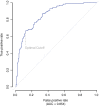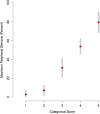A clinical and proteomics approach to predict the presence of obstructive peripheral arterial disease: From the Catheter Sampled Blood Archive in Cardiovascular Diseases (CASABLANCA) Study
- PMID: 29876944
- PMCID: PMC6489776
- DOI: 10.1002/clc.22939
A clinical and proteomics approach to predict the presence of obstructive peripheral arterial disease: From the Catheter Sampled Blood Archive in Cardiovascular Diseases (CASABLANCA) Study
Abstract
Background: Peripheral arterial disease (PAD) is a global health problem that is frequently underdiagnosed and undertreated. Noninvasive tools to predict the presence and severity of PAD have limitations including inaccuracy, cost, or need for intravenous contrast and ionizing radiation.
Hypothesis: A clinical/biomarker score may offer an attractive alternative diagnostic method for PAD.
Methods: In a prospective cohort of 354 patients referred for diagnostic peripheral and/or coronary angiography, predictors of ≥50% stenosis in ≥1 peripheral vessel (carotid/subclavian, renal, or lower extremity arteries) were identified from >50 clinical variables and 109 biomarkers. Machine learning identified variables predictive of obstructive PAD; a score derived from the final model was developed.
Results: The score consisted of 1 clinical variable (history of hypertension) and 6 biomarkers (midkine, kidney injury molecule-1, interleukin-23, follicle-stimulating hormone, angiopoietin-1, and eotaxin-1). The model had an in-sample area under the receiver operating characteristic curve of 0.85 for obstructive PAD and a cross-validated area under the curve of 0.84; higher scores were associated with greater severity of angiographic stenosis. At optimal cutoff, the score had 65% sensitivity, 88% specificity, 76% positive predictive value (PPV), and 81% negative predictive value (NPV) for obstructive PAD and performed consistently across vascular territories. Partitioning the score into 5 levels resulted in a PPV of 86% and NPV of 98% in the highest and lowest levels, respectively. Elevated score was associated with shorter time to revascularization during 4.3 years of follow-up.
Conclusions: A clinical/biomarker score demonstrates high accuracy for predicting the presence of PAD.
Keywords: Biomarkers; Diagnostic Score; Peripheral Arterial Disease.
© 2018 Wiley Periodicals, Inc.
Conflict of interest statement
Dr. Januzzi has received grant support from Roche Diagnostics, Siemens, Cleveland Heart Labs, and Prevencio; has received consulting income from Roche Diagnostics, Critical Diagnostics, Philips, and Novartis; and participates in clinical endpoint committees/data safety monitoring boards for AbbVie, Bayer, Pfizer, Novartis, Amgen, Janssen, and Boehringer Ingelheim. Mr. Magaret is a consultant to Prevencio, Inc. Dr. Gaggin has received grant support from Roche and Portola; has received consulting income from Roche Diagnostics, American Regent, Amgen, Boston Heart Diagnostics, and Critical Diagnostics; and has received research payments for clinical endpoint committees for EchoSense. Dr. Garasic has received consulting income from Siemens, Applied Clinical Intelligence, Bayer, Merck, Boehringer Ingelheim, and AbbVie. Ms. Rhyne and Dr. Barnes are employees of Prevencio, Inc. The authors declare no other potential conflicts of interest.
Figures



References
-
- Fowkes FG, Rudan D, Rudan I, et al. Comparison of global estimates of prevalence and risk factors for peripheral artery disease in 2000 and 2010: a systematic review and analysis. Lancet. 2013;382:1329–1340. - PubMed
-
- Hirsch AT, Criqui MH, Treat‐Jacobson D, et al. Peripheral arterial disease detection, awareness, and treatment in primary care. JAMA. 2001;286:1317–1324. - PubMed
-
- Aboyans V, Ho E, Denenberg JO, et al. The association between elevated ankle systolic pressures and peripheral occlusive arterial disease in diabetic and nondiabetic subjects. J Vasc Surg. 2008;48:1197–1203. - PubMed
-
- Aboyans V, Lacroix P, Lebourdon A, et al. The intra‐ and interobserver variability of ankle‐arm blood pressure index according to its mode of calculation. J Clin Epidemiol. 2003;56:215–220. - PubMed
Publication types
MeSH terms
Substances
LinkOut - more resources
Full Text Sources
Other Literature Sources
Medical

